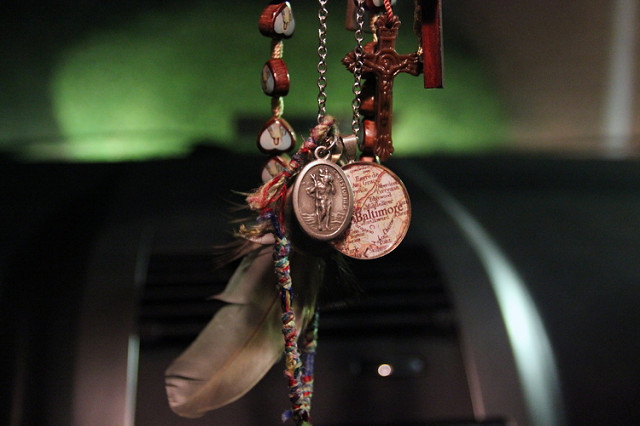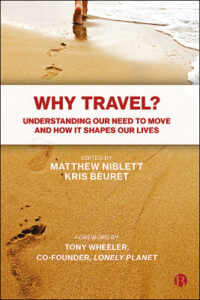In the hands of the gods: Deities, saints and spirits of travel

A medallion depicting Saint Christopher – the patron saint of travellers – hangs from the rear view mirror of a car. Image 24.064/365- St. Chris © viviandnguyen licensed under CC BY-SA 2.0
In Japan, before embarking on a journey travellers may purchase, or be given by a loved one, a ‘bujikaeru,’ a small model or plush toy of a green frog, to carry with them to bring safety on their travels.[1] In Catholic countries people may be more likely to carry a silver Saint Christopher medallion than a frog, but the aim – to invoke divine or spiritual protection for the traveller – is the same, and similar practices have been carried out by people of different faiths for many centuries.
Travel is such an integral part of our lives, and often a dangerous or unsettling experience – especially in the past – that it is unsurprising people have called on their spiritual beliefs to feel protected on their journeys. The Ancient World was replete with deities who were thought to look over the fate of travellers. In the Greco-Roman pantheon these included winged Hermes, the messenger of the gods, and Hecate the goddess of the crossroad. Janus was the Roman god of doorways and new beginnings, whose protection would be sought at the start of a journey; and Redicolus and Fortuna Redux were deities who both represented safe returns. Similarly the goddesses Abeona and Adiona watched over the safe leaving and returning of children when they travelled from home. As might be expected given the perils of travelling by sea, Poseidon, god of the sea, was often given offerings or promises of sacrifice on safe return by those about to set out on sea voyages; these may have been carried out at temples located on the seashore or at shrines found on board many ships.[2] Many other ancient cultures also worshipped travel gods, including the Egyptian moon god, Khonsu, whose name means ‘traveller’, and the Mayan god of merchants and travellers Ek Chuaj.
In modern day Hinduism there are a variety of deities who are associated with travel in different forms. The elephant-headed god Ganesh is most often represented as Lord of Obstacles (of removing and placing obstacles in people’s paths as appropriate) and in some local traditions this has led him to be regarded as the god of travellers.[3] Another Hindu deity linked to travel is Akash Bhairab, the god of the sky, whose image appears within the symbol of Nepal Airlines. In 2007 it was reported that the airline sacrificed two goats on the runway in front of a Boeing 757 which had been experiencing faults. The animals were sacrificed in honour of Akash Bhairab and the company reported that the flight following the sacrifice was successful.[4]
In Japan it isn’t only the bujikaeru ‘safety frog’ that protects travellers: in Shintoism local gods of the road and paths, known as Chimata-no-Kami or Dosojin, are thought to protect travellers against disease and malicious spirits. In Buddhist traditions in Japan and elsewhere travellers can appeal to certain boddhisatvas (beings who have attained enlightenment) for assistance. For example, one of the most popular deities in Japan is the boddhisatva Jizo (known by other names in different countries), whose statues are found commonly on roadsides, and who offers protection for children, foetuses and travellers.
Monotheistic religions may not allow for separate travel deities but it is common for believers to offer prayers to their God for safe travels, and in Catholicism and Orthodox Christianity believers may appeal to certain saints. The most famous patron saint of travel is St Christopher[5], who is said to have carried Christ as a baby across a river, and whose image is shown on medallions and holy cards carried by many Catholics, and displayed in cars and buses across France, Spain and Latin America. Pilgrims on the Way of St James, to Santiago de Compostela in Northern Spain, have traditionally carried scallop shells as a symbol of the Saint and a reminder of God’s protection.
Even the relatively modern practice of purchasing travel insurance, which may seem a secular and rational act aimed at mitigating negative consequences of travel rather than warding them off, has been found to have a superstitious element. Researchers have shown that for many people the very fact they have purchased insurance leads them to believe that bad things are less likely to happen on their journey. The act of buying insurance could be likened to an act of sacrifice or of carrying a charm, in some way appeasing the gods, fates or spirits. Interestingly this unconscious effect on risk perception was found as much in people who consciously reject superstition as in those who embrace it.[6]
It seems, then, that the desire to be protected on our travels runs deep within the human psyche – an understandable feeling given the dangers often presented by travel: even in the relative safety of our modern travels, road traffic accidents are the tenth biggest cause of death globally.[7] But travel is not only a physically dangerous activity; it can also be unsettling psychologically, removing the traveller from all that is familiar. To some extent the performance of religious rituals, including the simple act of carrying a special object on the journey, may play a role in alleviating this feeling, helping the traveller feel more connected with home. Professor Steven Muir, in his examination of travel in ancient Greece and Rome, claims that “gods and rituals … played a key role in the process of travelling itself,” and that “interactions with the gods while on the road served to reassert the identity of travellers, linking them with the familiar rituals of home and city.”[8]
When we think of ‘religion and travel’, it may be the sacred journeys of pilgrims that first spring to mind, or of missionaries travelling to far off lands to spread their faith. Such religiously motivated journeys are immensely important, and many millions of such religious journeys are made each year.[9] But, as this brief survey of gods and spirits exemplifies, travel and spiritual belief are intertwined in myriad other ways, and these deep cultural and psychological connections play a fundamental role in shaping our travel behaviours. Such issues are explored by the Independent Transport Commission’s Why Travel? project, which takes perspectives from across the arts and sciences to examine the complex motivations that shape our travel. Our aim is to better understand human travel and – crucially – to inform better decision-making about travel in to the future. For more information on the project, including expert views and current research, see www.whytravel.org.
See also:
Religion topic page
Pilgrimage blog post
Notes:
[1] This tradition comes from a play on words. ‘Buji’ means safe and ‘kaeru’ means both frog and return; bujikaeru is therefore both a ‘safe frog’ and a ‘safe journey.’
[2] Travel and Religion in Antiquity edited by Philip A. Harland (2011) Wilfred Laurier University Press
[3] In this blogpost actor Nigel Planer explains one story of Ganesh the god of travel as told to him in India in the 1970s: https://www.huffingtonpost.co.uk/nigel-planer/nigel-planer-india_b_8783612.html
[4] http://news.bbc.co.uk/1/hi/6979292.stm
[5] In the Coptic tradition the patron saint of travellers in Saint Menas, whom many scholars believe was historically the same person as Saint Christopher – Christopher being a given name meaning ‘Christ-bearer’.
[6] See https://www.nytimes.com/2008/05/06/science/06tier.html describing research by Orit Tykocinski, a professor of psychology at the Interdisciplinary Center Herzliya in Israel.
[7] Road injuries killed 1.3 million people in 2015, about three-quarters (76%) of whom were men and boys. http://www.who.int/mediacentre/factsheets/fs310/en/
[8] Steven Muir (2011) “Blest be the ties that bind – religion on the roads of ancient Greece and Rome”. In Travel and Religion in Antiquity, Philip A. Harland (ed.) Wilfred Laurier Press.
[9] According to the Alliance of Religions for Conservation (ARC) at least 200 million people go on a pilgrimage every year.


